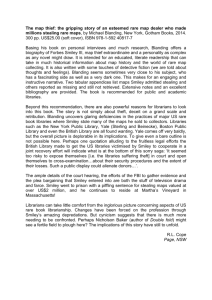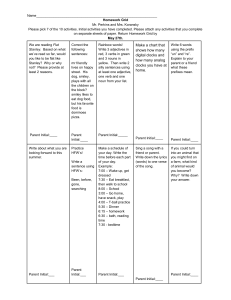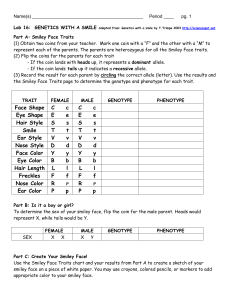GENETICS WITH A SMILE Adapted from: Genetics with a smile by T
advertisement
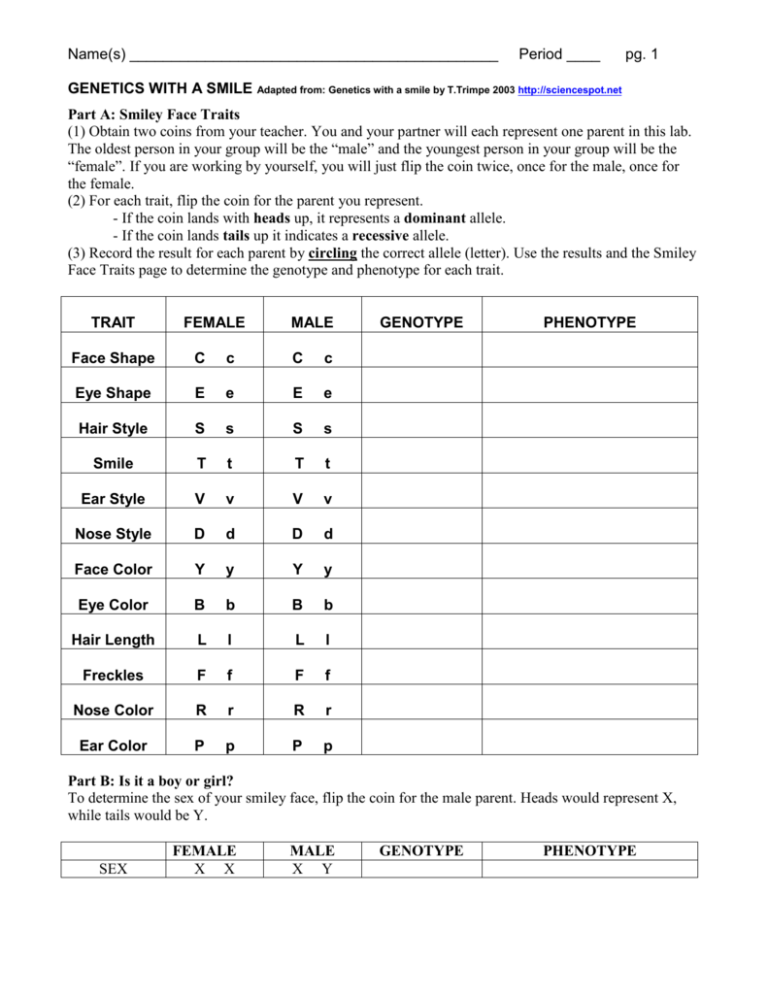
Name(s) ____________________________________________ GENETICS WITH A SMILE Period ____ pg. 1 Adapted from: Genetics with a smile by T.Trimpe 2003 http://sciencespot.net Part A: Smiley Face Traits (1) Obtain two coins from your teacher. You and your partner will each represent one parent in this lab. The oldest person in your group will be the “male” and the youngest person in your group will be the “female”. If you are working by yourself, you will just flip the coin twice, once for the male, once for the female. (2) For each trait, flip the coin for the parent you represent. - If the coin lands with heads up, it represents a dominant allele. - If the coin lands tails up it indicates a recessive allele. (3) Record the result for each parent by circling the correct allele (letter). Use the results and the Smiley Face Traits page to determine the genotype and phenotype for each trait. TRAIT FEMALE MALE Face Shape C c C c Eye Shape E e E e Hair Style S s S s Smile T t T t Ear Style V v V v Nose Style D d D d Face Color Y y Y y Eye Color B b B b Hair Length L l L l Freckles F f F f Nose Color R r R r Ear Color P p P p GENOTYPE PHENOTYPE Part B: Is it a boy or girl? To determine the sex of your smiley face, flip the coin for the male parent. Heads would represent X, while tails would be Y. SEX FEMALE X X MALE X Y GENOTYPE PHENOTYPE Name(s) ____________________________________________ Period ____ pg. 2 Part C: Create Your Smiley Face! Use the Smiley Face Traits chart and your results from Part A to create a sketch of your smiley face on a piece of white paper. You may use crayons, colored pencils, or markers to add appropriate color to your smiley face. SMILEY FACE TRAITS FACE SHAPE NOSE STYLE Circle (C) Oval (c) EYE SHAPE Star (E) Down (D) Up (d) FACE COLOR EYE COLOR Yellow (Y) Brown (B) Green (y) Blue (b) HAIR LENGTH FRECKLES Long ( > 1 inch) (L) Present (F) Short ( < 1 inch) (l) Absent (f) NOSE COLOR EAR COLOR Red (R) Purple (P) Orange (r) Pink (p) Blast (e) HAIRSTYLE Straight (S) Curly (s) SMILE Thick (T) Thin (t) EAR STYLE Curved (V) Pointed (v) SEX XX = female = pink bow in hair XY = male = blue hat on head Name(s) ____________________________________________ Period ____ pg. 3 Part C: Create Your Smiley Face! Use the Smiley Face Traits chart and your results from Part A to create a sketch of your smiley face on a piece of white paper. You may use crayons, colored pencils, or markers to add appropriate color to your smiley face. Name(s) ____________________________________________ Period ____ pg. 4 Part D: WRAPPING IT UP! (1) How many dominant traits did your smiley face have? _________ (2) How many recessive traits did your smiley face have? _________ (3) What is the probability that a smiley face will have a green face, given that the parents were both hybrids, Yy x Yy? _________ out of __________ or ________ % (4) How would the smiley faces change if one of the parents were homozygous dominant for all the traits while the other was heterozygous? (5) How would the smiley faces change if one of the parents were recessive for all the traits while the other was heterozygous? (6) Grandma and Grandpa Smiley are heterozygous for the star eye shape. If one of their heterozygous children married a girl with blast-type eyes, what percentage of their grandchildren should have starry eyes? What percent would have blast-type eyes? Create a Punnett square to help you find your answers. (10) Baby Smiley has curly hair, but neither of her parents do! Is this possible? Create a Punnett square to help you find your answer. (BONUS) Aunt Smiley has the cutest pointed ears and would love to have children with pointed ears! What type of ears would her husband need to have in order for her to get her wish? Give the genotype and phenotype as part of your answer.
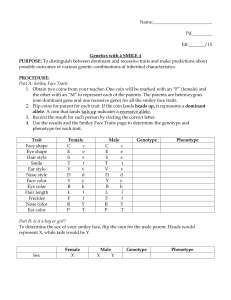

![To create a “smiley face” [ ] in your Word document take just a few](http://s3.studylib.net/store/data/008488693_1-f8534d2dd9ab3b827d6566593b8db18e-300x300.png)

